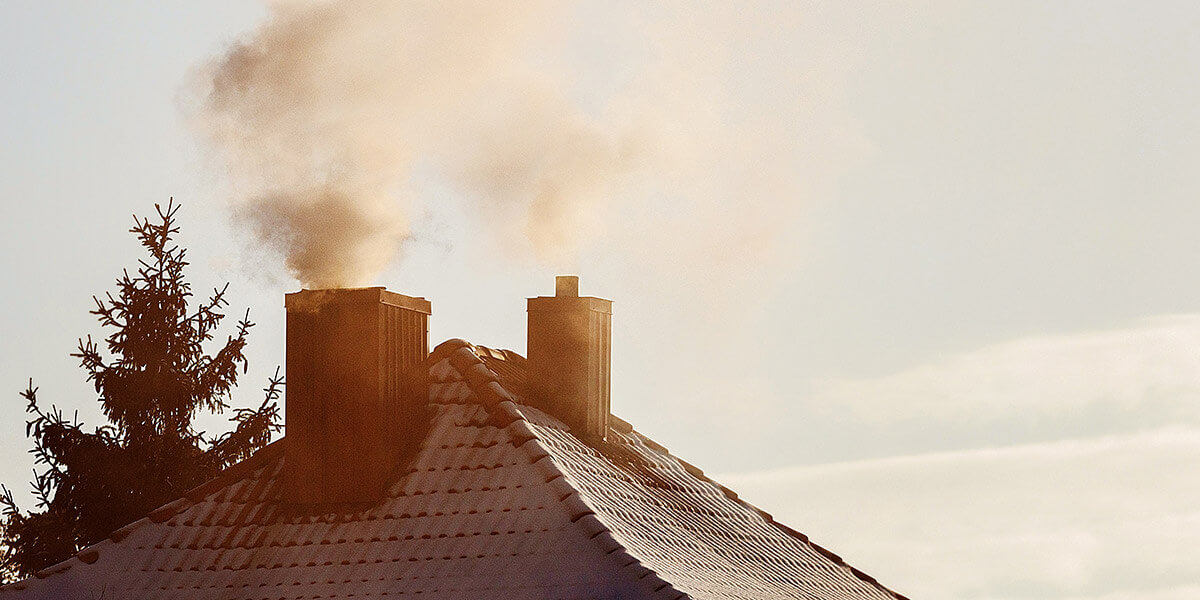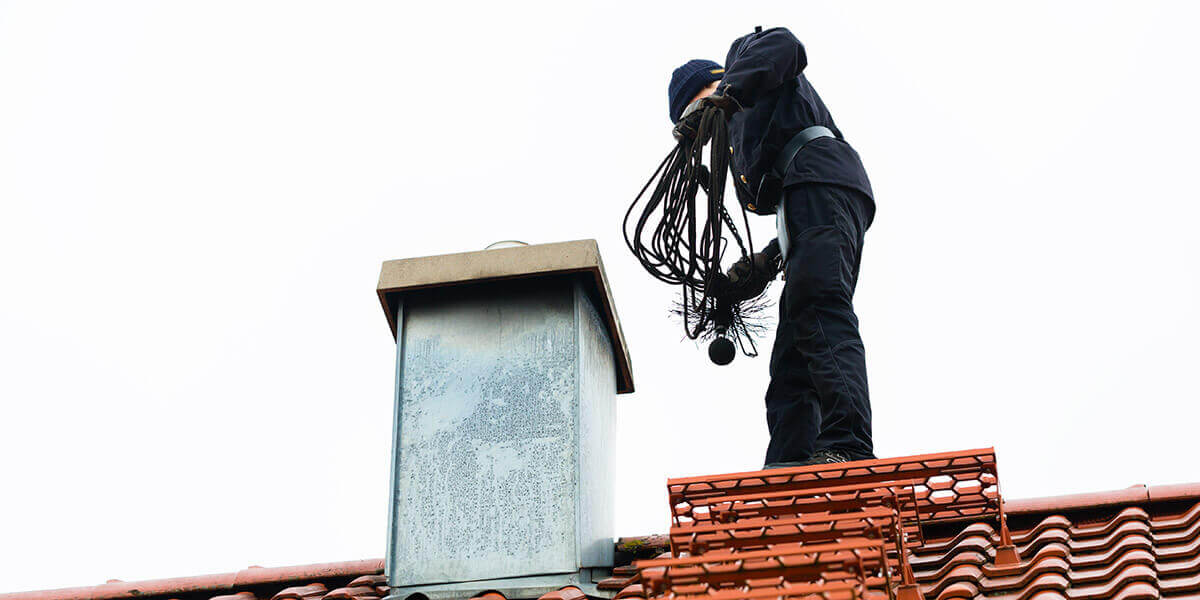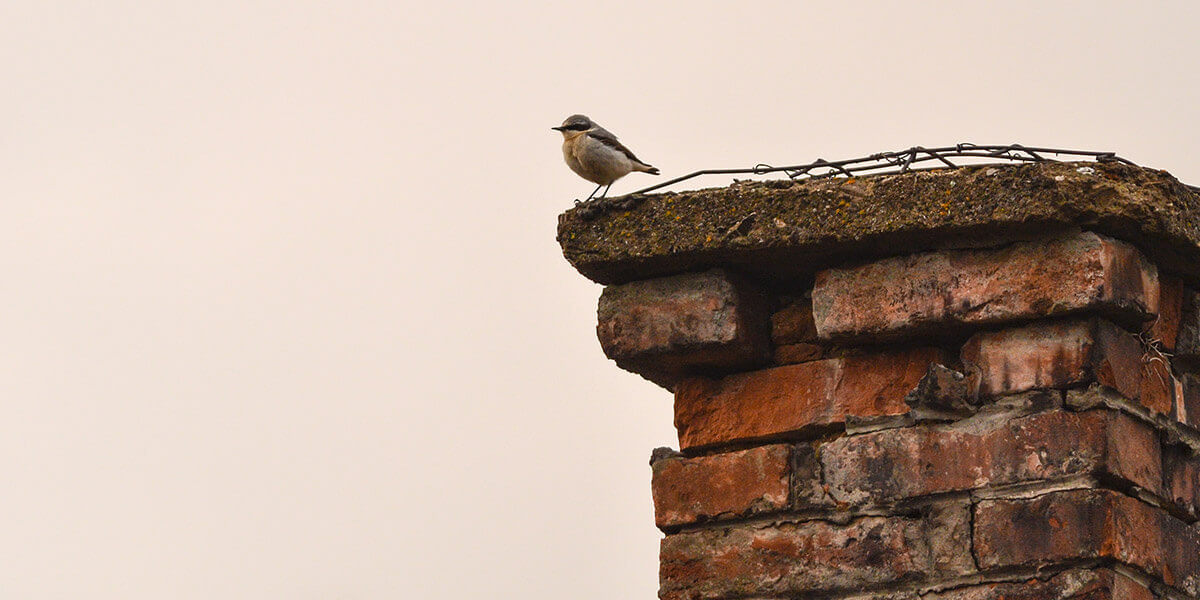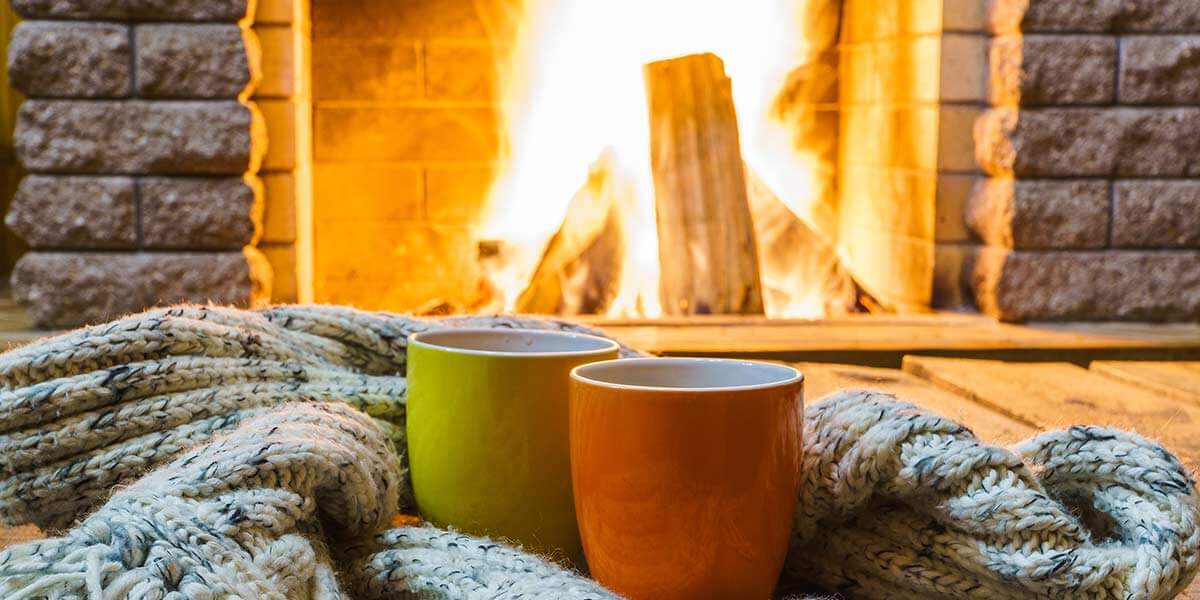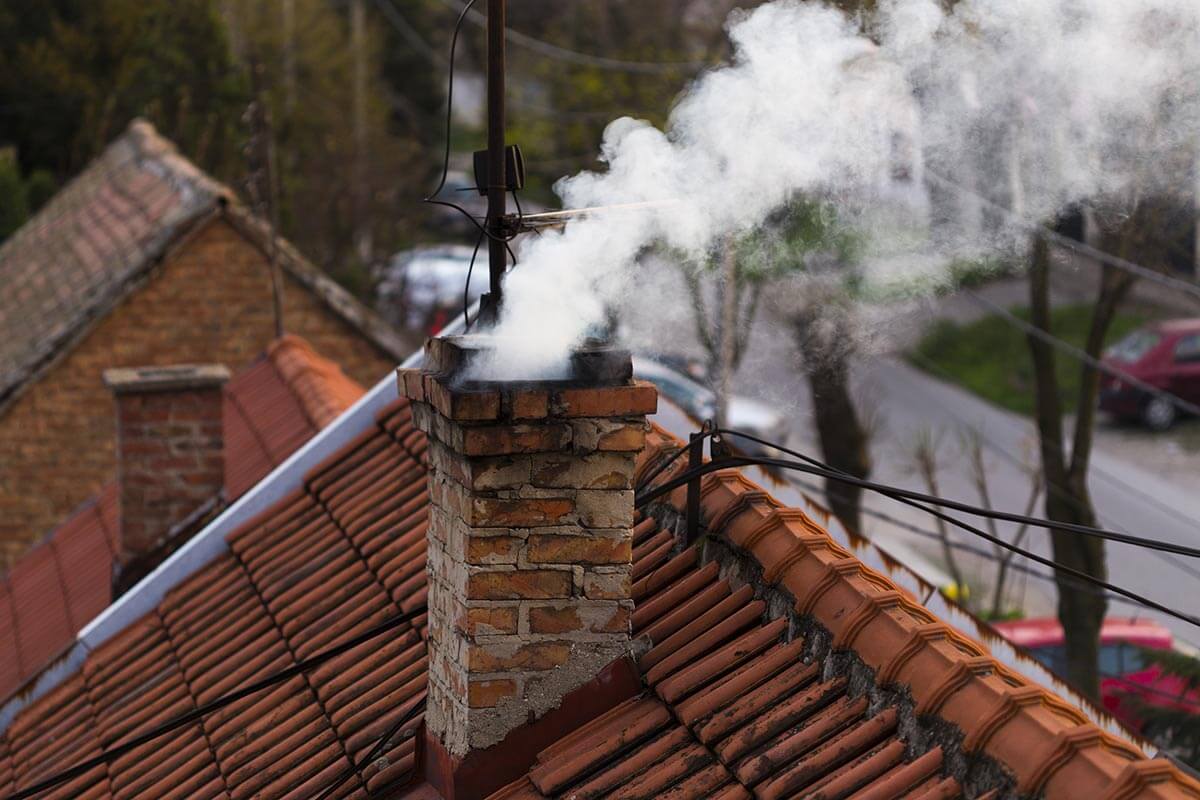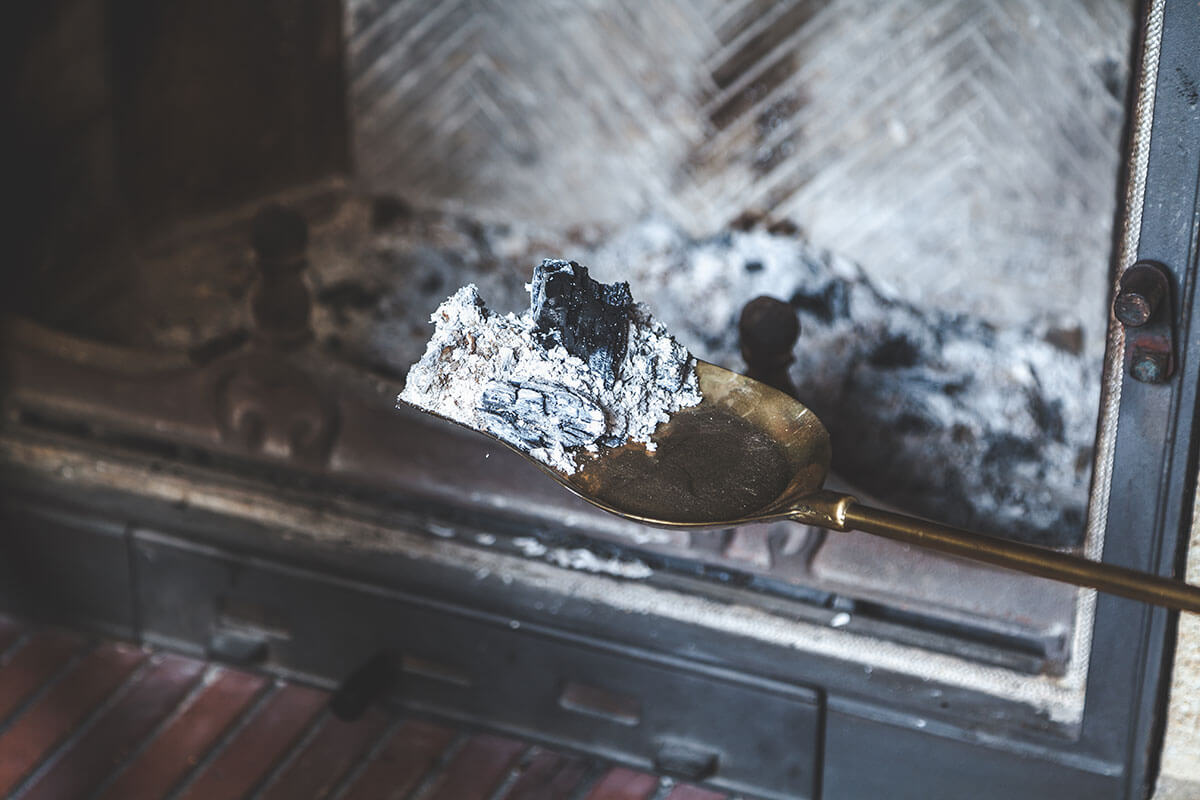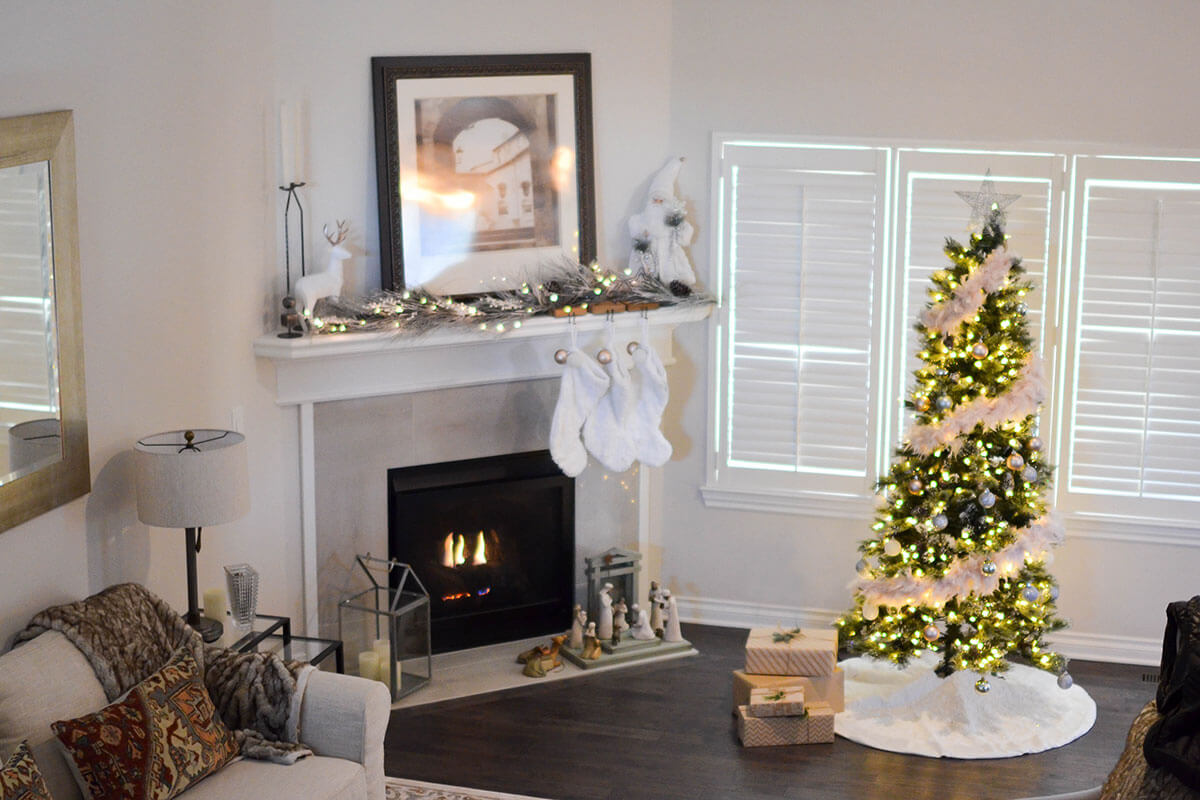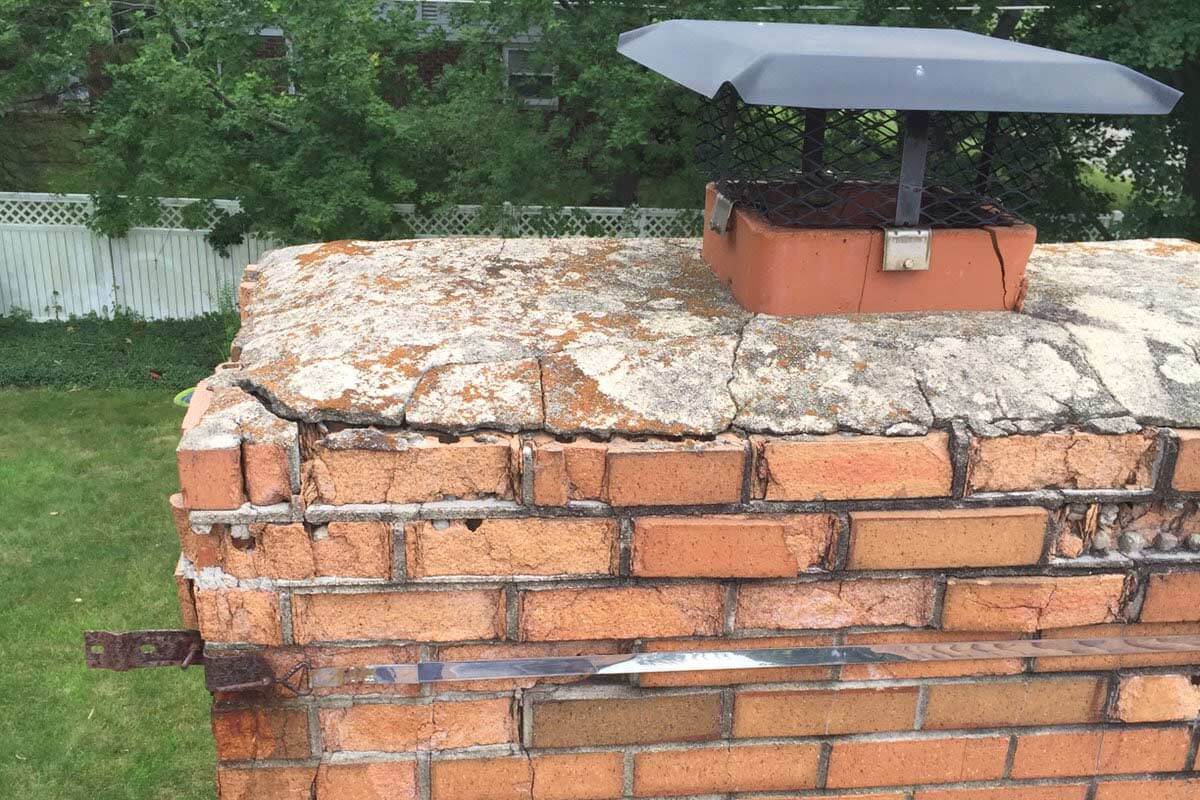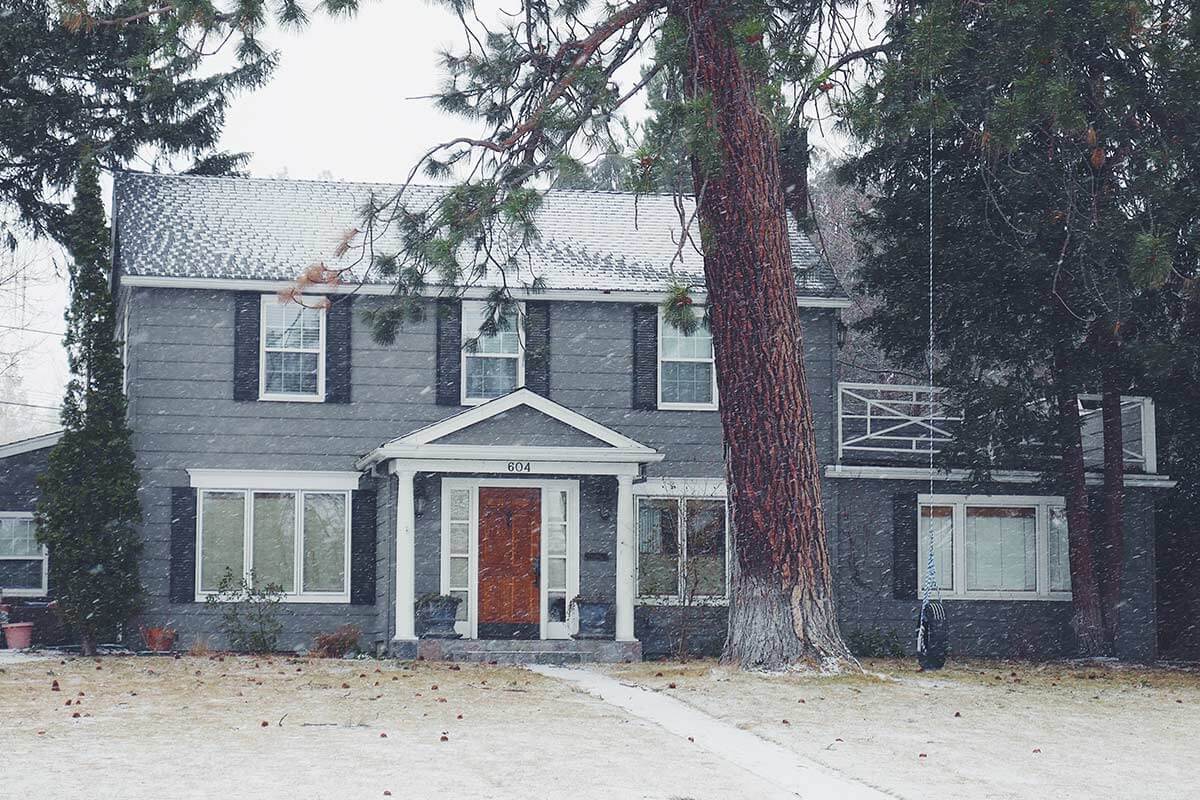Why Do I Have a Smokey Chimney?
We get the question often from homeowners, “Why do I have a smokey chimney?”
Most of the time the answer is typically due to a drafting issue.
The chimney is designed and constructed to pull air up, out, and away from the home. However, there are a few common reasons you may be experiencing what industry professionals refer to as a drafting issue, which is when air or smoke is coming back into the home through the chimney. It is extremely important to have any drafting issues addressed, which causes a smokey chimney, as the fireplace is often not the only component of a home that uses the chimney. Other heat systems such as the furnace and water-heater are also exhausted through the chimney, which means if the air is coming back down the chimney rather than out, the natural gases from those systems may be as well.
What causes drafting issues leading to a smokey chimney?
- Cause: Build-up of creosote or soot in the chimney’s flue system can cause a negative, or down draft in the chimney.
Solution: Schedule a chimney sweep and inspection. - Cause: Holes in the chimney’s flue system (between flue-tiles or throughout the chimney liner) can also be a cause for drafting issues.
Solution: Schedule an assessment of the flue system (tiles or liner) - Cause: Missing rain-caps, which serve several important functions for the chimney.
Solution: Schedule an assessment and rain-cap installation. - Cause: Large trees fall directly above the flue or top of the chimney.
Solution: Schedule an assessment and tree trimming. - Cause: Wind is circulating from larger homes, trees or mountains that surround your home.
Solution: Schedule an assessment to determine the height of the flue.
It’s not normal to be experiencing a downdraft from your chimney and it could turn out to be quite hazardous. If it smells smokey or musty or just down right strange, be sure to give your Indianapolis Brick + Ember Outfitters a call right away at 317-500-1250. Risking the health and safety of your home and those in it is not worth neglecting the issue. Often times, getting rid of a smokey chimney issue can be as simple as a sweep and inspection.
Do I Need a Chimney Sweep for My Indianapolis Home?
Contrary to many homeowner’s assumptions, the need for a chimney sweep does not depend on the frequency of use. Whether you have used your chimney in the last year or not, yes you will need an annual chimney sweep for your Indianapolis home before you start burning again for the season.
Why is an annual chimney sweep necessary
Your chimney serves as an exhaust to your fireplace and in many cases, the furnace, too. When a chimney is not in use, birds, insects, and other unwanted critters could take up real estate in your chimney. You’ll want to have any remnants left by these guests removed, and any damage addressed. Additionally, the fluctuation of Indianapolis weather throughout the year can take a toll on the masonry and the internal components of a chimney. The possible freezing and thawing, expanding and contracting of water in any deteriorated mortar joints, or porous brick, will perpetuate the breaking down of your chimney’s structure.
Especially if the chimney has been used, it is absolutely recommended by industry professionals to have the chimney cleaned and inspected annually. When wood is burned, creosote is left behind, and a fire burning inefficiently (not hot enough) allows creosote to build up in the flue system. Creosote is a flammable tar-like substance that can re-ignite and lead to flue-fires, which crack flue-tiles and cause serious structural hazards for your home.
What should I keep in mind before I call my chimney sweep?
Be sure that your annual chimney sweep should be performed by a certified chimney sweep. Your Indianapolis Brick + Ember Outfitters have been certified by the Chimney Safety Institute of America to ensure that you receive a quality sweep and inspection service that is in line with chimney safety regulations and best burning practices.
If you have not had your chimney swept or inspected this year, be sure properly prepare your home and give us a call 317-500-1250 to schedule your appointment.
What Should I Do About a Bird in My Chimney?
We’ve all heard of snowbirds, bluebirds and jay birds, but have you heard of the poor, pesky chimney bird? If you’re a Indianapolis homeowner, you may have had the issue of a chimney bird getting stuck in your chimney. Our Indianapolis trees are plentiful and mature, so this is a fairly common phenomenon.
What should I do about a bird in my chimney?
Although we deal with all things chimney, it’s not traditionally in our job description to save you from the foul play (pun intended) in your smokestack. But we can offer you some guidance on how to get one of those pesky chimney birds out if it’s stuck in your chimney (not fireplace).
- Open the fireplace damper.
- Put an open box (open side up) in the fireplace opening about one inch from the top of the fireplace. You can use a fireplace gate or another box to adjust it to the right height.
- Turn on a flashlight and put it inside the box, then replace the box to its original location.
- Make the room as quiet as possible, silencing TVs and music. Wait silently until the bird enters the box.
- Trap the bird by sliding a piece of cardboard over the open box. Take the box outside and remove the cardboard to set the bird free.
If the bird is in your fireplace box, close off all entrances to the room, as well as hallways with sheets hung by thumbtacks. Open the door or screen slightly and trap the bird by tossing a towel over it. Gather up all corners of the towel, keeping the bird inside and carry it outside to release that chimney bird back into the wild.
What do I do if the bird is flying free throughout my room?
Dim the lights in the room and guide the bird with a broom toward the open door or window. In the event that it’s dark outside, turn on an exterior light to help guide the bird to the exit.
Although we know that dealing with birds in chimneys can be stressful for homeowners, keep in mind that it is equally unnerving for the bird. Try to stay as calm as possible and follow our steps to make your chimney a bird free establishment.
Why do birds and critters get stuck in chimneys?
Houses today are frequently built with small metal flue pipes instead of clay liners. These flues can prove to be deadly for animals that are unable to establish a solid grip on the slippery metal, causing them to fall into the fireplace. The Chimney Swift bird is notorious for this, hence the name.
A great way to make sure birds and critters haven’t gotten stuck in your chimney is to keep up with your annual chimney and fireplace maintenance and schedule a chimney sweep. Be sure properly prepare your home and give us a call 317-500-1250 to schedule your appointment.
How to Weatherproof a Fireplace
We understand the comfort of sitting in front of the fireplace while the warmth surrounds the room. The problem is that a big percentage (some say up to 90%) of that warmth is distributed inefficiently in the room and home causing you to lose a lot of that heat that is being generated. That is why the need to weatherproof your fireplace is so important.
Here are some fireplace weatherproofing tips from the U.S. Department of Energy that can help reduce the heat loss from your wood-burning fireplace and make your home heating more efficient:
- Apply heat-resistant caulk around the fireplace hearth.
- Ensure that the seal on the fireplace damper, when closed, is snug and secure. If you can't tell, call your local chimney and masonry company and they can inspect it for you.
- Adjust the size of the damper opening to the size of the fire you plan to build: a narrow opening for a small fire and a wide opening for a large one. With a flashlight in hand, we can help you get a good feel for your fireplace damper.
- Before opening the fireplace damper to light a fire, counteract the fireplace's quest to pull cold air into your home through small gaps, windows and doors by closing the doors that lead into the room and opening the window located closest to the fireplace by about 1 inch.
- Lower your thermostat setting to between 50 and 55 degrees while the fireplace burns wood.
Your fireplace damper plays a significant role in weatherproofing your fireplace.
The purpose of the fireplace damper is to prevent heat loss when the fireplace is not being used. Don't forget to open it before you start a fire. But when the fire is completely out (usually sometime the following day), don't forget to close it. An open damper is like an open window, allowing huge amounts of heated air to escape.
When you are ready to light a fire, open the damper completely. Some people try to operate the fireplace with the damper closed partially, in an effort to get more heat into the room.
But you won't gain much, if anything, by closing it partially, and you might gain a house full of smoke! No matter how you operate it, a standard open fireplace is not an efficient heater. Its purpose is atmosphere and entertainment, so forget about efficiency. Open that damper, and leave it open until the fire is out.
Can a fireplace take the place of a furnace?
No. Fireplaces, unless you live in a single-room cabin, they are basically good for heating one room and only for a period of hours.
That being said, it’s important to nip heat loss in the bud because of the inefficiencies: A fireplace may actually cause your heat bill to rise because you have to run your furnace longer to make up for the heat lost through inefficiency.
Here are some ways to keep much of the heat from your wood-burning fireplace or chimney.
- Use a flue sealer: Flue sealers are removable stoppers that prevent air from escaping through the chimney. These inflatable devices made from heavy-gauge plastic are inexpensive, and easy to install and remove. Place the flue sealer just below the damper to prevent heat loss and downdrafts when the fireplace is not in use.
- Caulk it: Make sure to apply caulk around the fireplace hearth. Failure to seal or doing it improperly is a main way that many fireplaces are losing heat.
- Seal off the room: Another way to reduce heat loss is close the room’s doors if you can and to crack open the nearest window, no more than an inch. This will actually help the fire to emanate and heat the air, creating a feeling of warmth all around.
- Adjust the thermostat: A lot of people run their heating units too high while using a fireplace. To do its job, a good setting for the thermostat is 50° to 55°F.
- Install a heat-air exchange system: A heat exchanger captures air from the room and channels it through hot tubes, redistributing heat and bringing additional warmth. As a result, you get more bank for the bucks you’ve spent on wood.
As the temperature continues to drop and the winter wind kicks in, many homeowners are looking to their fireplaces to provide more heat in their homes.
But the truth is, chimneys take a beating from severe weather extremes all year round, so weatherproofing your chimney is a simple and easy task that will not only extend the life of your chimney for years, but will help keep the right temperature within your walls through all seasons.
Call or visit our website us to schedule an assessment so you can keep your home warm all winter long!
Understanding Your Fireplace Damper
If you’ve ever filled your house with smoke just after starting a roaring fire, then you’ve probably wondered how a fireplace damper works. Unfortunately, a house full of smoke is a common signal that the damper has not been properly adjusted for fireplace use.
What is a fireplace damper?
Think of a chimney damper like a lid for your fireplace. It is located in the flue, which is the air shaft through which smoke and air can travel in and out of your chimney, and is located above the firebox where the fire is made, and is in use both when fireplace is active and inactive. We commonly think of chimneys as avenues for smoke to escape from your home, but they are also a way for air to come in. Knowing exactly what your chimney damper is, what it does, and how to control it will ensure better, safer, and more enjoyable fireside chats.
Inactive Fireplace
As mentioned, when your fireplace isn’t in use, your chimney damper still has a job to do. When there's no fire, keeping the fireplace damper shut tight prevents cold outside air from entering the house. This helps create energy efficiency. An open chimney damper will allow air into your home, so if it’s a cold night and you just can’t seem to warm up, make sure that your chimney damper is closed. A closed chimney damper will prevent unwanted air of any temperature from making its way into your home.
Active Fireplace
When the fireplace is in use, an open fireplace damper prevents smoke from filling up your home by giving it a way out through the flue. When starting a fire in your fireplace, making sure that your chimney damper is open is imperative to a healthy burn. Health risks associated with smoke inhalation are very serious, and you should never have to worry about putting your family in danger when building a fire. An open chimney damper will filter smoke out and keep the air in your home breathable and free of harm.
If you alter the amount that the damper is actually opened or closed, you limit the amount of oxygen that can enter the flue and interact with the fire. In addition to a fuel like gas or wood, oxygen is a crucial element to maintaining a fire. So, knowing how to control your damper will give you a huge degree of control over your flames that you may have overlooked until now.
Where is a fireplace damper located?
The damper is located inside the flue.
Fireplaces are constructed fairly simply. The firebox, where the fire is actually burned, is located inside a room of the house, is surrounded by brick, marble, or is sometimes freestanding like a wood stove. The chimney houses the flue, which is the airway in which the smoke rises from the fireplace and exits through the roof. Conversely, outside air can enter through the flue into the firebox.
Sticking to these guidelines and knowing when and how to use your chimney damper will not only ensure a more enjoyable fireside experience, but knowing how it’s supposed to function can tell you if there are any problems with your chimney that need attention.
Thinking you might need a set of professional eyes on your chimney and fireplace this winter? Call or visit our website us to schedule an assessment so you can keep your home warm all winter long!
How to Safely Remove Wood Ashes From Your Fireplace
The burning of solid fuels in your stove, fireplace or insert, be it wood, coal or pellets, will inevitably leave behind ashes that need to be removed, regardless of how efficiently your particular unit burns. These remaining ashes must be removed periodically to prevent them from harming both the performance and durability of your unit. The frequency of the ash removal will depend on the product itself, how efficiently it burns, and the type of fuel being burned. The primary concern should be keeping you and your family members safe.
There are many ways this ash can be put to good use. Did you know that it is not a good idea to remove the ash from the fireplace or wood stove every time you build a fire? As it turns out, having a 1-inch layer of ash on the floor of the firebox during the regular heating season will make it easier to build and maintain a fire. The hot coals tend to nestle into the ash and glow, adding more heat to the fuel and reflecting the heat back into the fire.
How to Safely Remove Wood Ashes from Your Fireplace
- Trash the ash. A wet/dry vacuum with a disposable bag will take care of the job once the pile has cooled for at least four days.If you don't have one of those heavy-duty suckers, or just don't feel like hauling it out, here is an alternative approach: After the ash is completely cold, sprinkle it with damp tea leaves or coffee grounds to cover the stale smell and keep down dust (so you don't inhale it). Then scoop the pile with a fireplace shovel leaving an inch or two behind, and dump it into a metal can, bucket, or even an old stockpot. Discard the mess outside, ideally in a metal trash container, but definitely away from your house.
- Brush it off. If you have smoke stains on your fireplace facing, begin by squirting them with water. It will keep the cleaning solution from soaking in too fast (this is particularly important with brick). Then dip a brush in a solution of ¼ cup all-purpose cleaner to 1-gallon water; give spots a quick scrub; rinse with a clean sponge; let dry. For marble or other stones, squirt with water, and then go over with a soft cloth dipped in mild dishwashing liquid and water. Rinse and wipe dry.One exception: If brick facing is more than 50 years old, it may crumble if you scrub with a cleaner. Just vacuum the surface with your soft-brush attachment.
- Clear things up. To remove light soot or a cloudy film from glass doors, mix a solution of equal parts white vinegar and warm water and pour into a spray bottle. Spritz a bit on a paper towel and dip it into the fireplace ashes to use as a gentle abrasive. To finish, spray glass and wipe clean with a microfiber cloth. If soldered-on gunk won't budge (and if you really care), scrape it away with a razor blade.
Every year, hundreds of thousands of dollars in damage occurs and dozens of families are displaced because of fires in their homes that are caused by the improper disposal of fireplace ashes. According to statistics released by the National Fire Protection Association, almost 10,000 fires are caused yearly due to improperly removing and discarding ashes. Fireplace and wood stove ashes retain enough heat to ignite other combustible materials for several days after a fire. All one of these coals needs to flare up again is the addition of more oxygen. Therefore, extra care should be used in the storage and final disposal of them. There’s a reason fire departments often return to the scene of a fire to spray more water on smoldering timbers and newly flared coals. Even though a fire may appear to be out, embers and ash are still capable of causing accidental fires.
Want to make sure your chimney and fireplace are in safe, working order for the winter? Call 317-500-1250 or visit our website us to schedule an assessment so you can keep your home warm all winter long!
Fire Safety Tips for the Holidays
From holiday candles to Christmas trees, dangling garlands and fireplaces, seasonal decorations can often be hazardous if not properly put up with care, or if it’s placed next to a potentially dangerous item. Follow our fire safety tips to keep your holidays safe for you, your family and your guests.
-
Inspect your lights before hanging
Don’t plug more than 3 strings into each other, throw out light strings that are worn or broken, and be sure to always unplug the lights before leaving the house or going to sleep.
-
Keep your Christmas tree healthy
Water it every day because dry needles and wood catch fire more easily. Just two or three days without water is enough to dry it out.
-
Place your Menorah or Kinara safely
Keep flammable items, including curtains and holiday decorations, at least 3-feet away from your candles. Place your menorah or kinara on a non-flammable surface to catch the melting candle wax, such as a tray lined with aluminum foil. Never leave lit candles unattended.
-
Use space heaters with care
They should only be used as temporary heating, should never be used with an extension cord, and should be plugged into a 20-amp circuit. Keep away from Christmas trees, because according to the USFA, heat sources too close to a tree account for 20 percent of Christmas tree fires.
-
Prepare your fireplace before lighting logs
Keep flammable items, such as wrapping paper (burning gift wrap is extremely dangerous), rugs and clothing, at least three feet away from your fireplace flames. Use a fire screen to keep embers and logs from escaping, and make sure all embers are fully extinguished before you turn in for the night.
Facts about home holiday fires
- One of every four home Christmas tree fires is caused by electrical problems.
- Although Christmas tree fires are not common, when they do occur, they are more likely to be serious. On average, one of every 32 reported home Christmas tree fires results in a death compared to an average of one death per 143 total reported home fires.
- A heat source too close to the tree causes one in every four Christmas tree fires.
- The top three days for home candle fires are Christmas, New Year’s Day, and Christmas Eve.
- Candles start two out of five home decoration structure fires.
Keep your holidays merry and bright by making these fire safety tips a priority during this festive season. Call or visit our website us to learn more about how to keep your home and family safe with annual chimney and fireplace maintenance visits.
What is the cost of a chimney inspection?
Whether you're burning logs or firing up the gas fireplace, chimney maintenance should be a top priority every year. Standard and basic chimney inspection costs vary depending on roof accessibility and the type of chimney you need inspected, but generally speaking you can plan to spend about $100 to $250.
Chimneys left unclean are a leading cause of structure fires, according to the National Fire Protection Association, which recommends an annual chimney inspection.
Different types of chimney inspection
- Inspection and cleaning
Chimney inspection costs vary depending on roof accessibility and the type of chimney to be inspected, but generally speaking these services will run anywhere from $100-$250. - Camera inspection
A camera chimney inspection cost, much like you would expect from a plumber inspecting clogged pipes, will typically be $50-$75. However, here at B+E, we include a camera inspection with all chimney sweeps, so you’re getting a two-for-one!
- Weather damage inspection
Following a major weather event, it’s a good idea to get a more thorough inspection of your chimney that includes the roof and attic. Special video equipment and other additional resources are often needed to properly determine if the structure is still sound. This service is typically an additional, separate fee that can only be determined once the scope of damage is assessed.
- Masonry repairs
If a visual inspection of a chimney reveals that some areas of the masonry are in need of repairs, a professional chimney mason can do tuck pointing which offers a great solution for cracks and breaks.
- Fire Damage
The cost for a chimney inspection for a chimney that has been damaged in a fire depends on how many stories the home has. A single-story home and a home with two or more stories will have significantly different prices.As a whole, chimney inspection costs for more serious damages and issues vary greatly on a wide range of factors. The best way to determine the most cost effective way to address any issues your home may have is to call local chimney and masonry company for an estimate specific to your needs.Chimney inspections should be done by professional chimney cleaning certified by the Chimney Safety Institute of America who will correctly ensure that your chimney is clear of creosote or other obstructions that could catch fire or prevent the smoke and other gases from venting outdoors. Don’t be fooled by the scammers out there. And trust us…they’re out there.
How to avoid chimney scams
- Don’t fall for “too good to be true” pricing: A legitimate company won’t take a ladder off the truck for $49.95. Then figure in equipment, payroll, liability insurance, gas, etc.
- A picture is worth a thousand words: Nowadays, chimney sweeps are trained to take pictures from start to finish, so don’t just take their word for it. Ask for visuals.
- Don’t get pressured into acting fast: Professionals don’t use scare tactics.
- Do your homework: Check reviews on Google, Facebook and Angie’s List.
Are you in need of a chimney inspection cost estimate? Give us a call or visit our website us to schedule a visit from one of our Outfitters!
What is a chimney inspection?
A chimney inspection is a service performed to look for buildups and blockages, followed by sweeping to remove problems inhibiting performance. In this article, we will outline what is involved in a good chimney sweep, as well as the three different levels of a chimney inspection that are available to you.
A good chimney company certified by the Chimney Safety Institute of America, will include these elements (and more!) within their chimney inspection:
- Rain Caps: highly recommended to prevent moisture from snow and rain to get down into your chimney, as well as birds and other critters.
- Brick and Mortar: important elements to take a close look at in every inspection to evaluate if any bricks exposed to weather need to be re-set, or if the mortar needs repointing.
- Flue Liner: cracked flue tiles and excessive creosote buildup would need attention, and if the chimney hasn’t been swept recently, they will recommend that it be cleaned before your first fire of the season in order to prevent unsafe consequences to wood-burning fireplaces, such as chimney fires.
- Fireplace Blower: these parts unfortunately do not have a filtering system to prevent buildup of dust and hair on the blower. Excessive buildup will shorten the life of this part and can even be a fire hazard.
Levels of chimney inspection
- Level One:
This level of a chimney inspection is recommended for a chimney that is under continued service, under the same conditions, and is with the continued use of the same appliance. If your appliance of venting system has not changed and you plan to use your system the same ways you have in the past, this level should be your base minimum action. - Level Two:
This level of a chimney inspection is recommended for a chimney that has had changes made to the system. These would include its shape, material, fuel type of flue. This level of chimney inspection is required upon the sale of a property, or following an operation malfunction or even that could have caused exterior damage to the chimney. - Level Three:
This level of chimney inspection is recommended for a chimney where a removal of a particular component of the building or chimney is necessary. This level of chimney inspection included everything that would be checked in a Level 1 and Level 2 inspection.
“I’m sure we’re fine for another year…”
If you choose to skip a chimney inspection or simply forget, you face the risk of running into all sorts of problems. These problems have the ability to cost you thousands of dollars in damagers, or could result in injury or death to those inside the home as well as neighbors. Residential fires are not something to be taken lightly, and the lack of regular chimney inspections is a very common cause of house-fires.
Prevent problems with an annual chimney inspection.
Call or visit our website us to schedule yours before you start using your fireplace on a regular basis this winter.
How the Freezing and Thawing Cycle Can Affect Your Chimney
The freeze/thaw cycle can cause significant damage to the bricks and the mortar of your chimney. Indiana weather can be all over the place sometimes, and although those surprise warm and sunny days we get in the middle of February are nice, did you ever stop to think what that nice, warm weather is doing to your chimney?
What is the Freeze/Thaw Cycle?
When you can see the snow melting off trees and hear the dripping of water off your roof, the precipitation gets into the porous surface of your mortar or even into the surface of bricks, then pools in the pores and stays there. When the weather freezes, that water freezes as well, and when water freezes, it expands which causes those pores to get bigger. When the weather warms up, the ice thaws, and there is room for even more water to collect. As this cycle continues, the pores get bigger and bigger, and this can cause major structural damage to your chimney, and proper maintenance is highly recommended.
Left unrepaired, the cracks of crumbling mortar, water-stained walls, rusted chimney damper or cracked chimney crowns, can lead to more costly damage to your chimney and home. Water can penetrate your chimney’s interior or even compromise other aspects of your home’s structure. Knowing this, the best way to handle chimney damage is to recognize it quickly and have it repaired immediately by a professional chimney company certified by the Chimney Safety Institute of America. This will highly increase your changes of preventing further deterioration.
If you are wondering how the freeze/thaw cycle has affected your chimney give us a call or visit our website us to schedule a visit from one of our Outfitters! Our CSIA-certified chimney technicians will apply a waterproofing formula to your entire chimney that creates a barrier against water penetration so that the freeze/thaw cycle will not occur.

